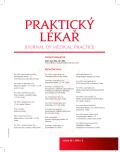Ankle brachial index and its interpretation in diabetic patients
Authors:
O. Machaczka 1; J. Janoutová 1; M. Homza 2; V. Janout 1
Authors‘ workplace:
Ostravská Univerzita v Ostravě
Lékařská fakulta
Ústav epidemiologie a ochrany veřejného zdraví, Ostrava
Vedoucí: prof. MUDr. Vladimír Janout, CSc.
1; Fakultní nemocnice Ostrava
Kardiovaskulární oddělení
Primář: MUDr. Miroslav Homza, MBA
2
Published in:
Prakt. Lék. 2016; 96(3): 107-113
Category:
Of different specialties
Overview
Ankle brachial index measurement is a non-invasive technique that is widely used by many medical practitioners to determine the peripheral vascular diseases, especially lower extremity arterial disease (LEAD). The principle of this method is to determine the ratio of systolic blood pressure at the ankle and a systolic blood pressure on the arm. However, in diabetic patients may be decreased the sensitivity of ankle brachial index due to diabetic neuropathy and presence of medial artery calcification, which reduces the reliability of the results that precludes the accurate determination of systolic blood pressure in the leg. LEAD in general occurs in a higher percentage in patients with diabetes than non-diabetic population, in addition the presence of diabetes worsens the prognosis of patients with LEAD, which occurs at an earlier age and is faster. A larger proportion of patients with LEAD suffer of atypical symptoms or are asymptomatic in the initial stage, however during this period significantly increases the risk of developing cardiovascular disease, so it is important to detect the disease. Ankle brachial index is generally useful diagnostic method, which the most positive aspect lays in the simplicity of measurement and financial modesty. But it is questionable whether the specifics of the diabetic population are an obstacle to using this method, which criteria are valid for the general population, and whether it is appropriate to choose the ankle brachial index measurement as an initial examination of PAD even in diabetic patients. The simultaneous absence of uniform standards for the measurement and calculation ankle brachial index leads to inconsistent results, which can cause clinical and economic issues with a significant impact on public health.
Keywords:
ankle brachial index – diabetes mellitus – lower extremity arterial disease
Sources
1. Aboyans V, Criqui MH, Abraham P, et al. Measurement and interpretation of the ankle-brachial index: a scientific statement from the American Heart Association. Circulation 2012; 126(24): 2890–2909.
2. ACC/AHA 2005 Practice guidelines for the management of patients with peripheral arterial disease (lower extremity, renal, mesenteric, and abdominal aortic). Circulation 2006; 113(11): e463–e465.
3. American Diabetes Association. Peripheral arterial disease in people with diabetes. Diabetes Care 2003; 26(12): 3333–3341.
4. Bartoš V, Pelikánová T, a kol. Praktická diabetologie. 5. vydání. Praha: Maxdorf 2011.
5. Brooks B, Dean R, Patel S, et al. TBI or not TBI: that is the question. Is it better to measure toe pressure than ankle pressure in diabetic patients? Diabetic Med 2001; 18(7): 528–532.
6. Bulvas M. Doporučení pro diagnostiku a léčbu ischemické choroby dolních končetin. Cor Vasa 2009; 51(2): 145–163.
7. Nam SC, Han SH, Lim SH, et al. Factors affecting the validity of ankle-brachial index in the diagnosis of peripheral arterial obstructive disease. Angiology 2010; 61(4): 392–396.
8. Eiberg JP, Lundorf E, Thomsen C, et al. Peripheral vascular surgery and magnetic resonance arteriography – a review. Eur J Vasc Endovasc Surg 2001; 22(5): 396–402.
9. Eliáš P. Dopplerovská ultrasonografie. Hradec Králové: Nucleus 1998.
10. Faisal AA, Cooper TC Jr. Onemocnění periferních tepen – diagnóza a léčba. Med Promoci 2008; 9(6): 14–19.
11. Forbang NI, Mcdermott MM, Liao Y, et al. Associations of diabetes mellitus and other cardiovascular disease risk factors with decline in the ankle-brachial index. Vasc Med 2014; 19(6): 465–472.
12. Jeevanantham V, Chehab B, Austria E, et al. Comparison of accuracy of two different methods to determine ankle-brachial index to predict peripheral arterial disease severity confirmed by angiography. Am J Cardiol 2014; 114(7): 1105–1110.
13. Kannel WB, Mcgee DL. Diabetes and cardiovascular disease. JAMA 1979; 241(19): 2035–2038.
14. Karetová D, Ingrischová M. Ischemická choroba dolních končetin u diabetiků – odlišnosti vzniku, projevů a diagnostiky. Med Promoci 2009; 10(2): 56–61.
15. Malý R, Chovanec V. Ischemická choroba dolních končetin a diabetes. Vnitř. Lék. 2010; 56(4): 341–346.
16. Ouriel K, McDonnell AE, Metz CE, Zarins CK. Critical evaluation of stress testing in the diagnosis of peripheral vascular disease. Surgery 1982; 91 : 686–693.
17. Potier L, Abi Khalil C, Mohammedi K, Roussel R. Use and utility of ankle brachial index in patients with diabetes. Eur J Vasc Endovasc Surg 2011; 41(1): 110–116.
18. Stoekenbroek RM, Ubbink DT, Reekers JA, Koelemay MJW. Hide and seek: does the toe-brachial index allow for earlier recognition of peripheral arterial disease in diabetic patients? Eur J Vasc Endovasc Surg 2015; 49(2): 192–198.
19. Škrha J. Diabetologie. Praha: Galén 2009.
20. Vojtíšková J, Seifert B. Oscilometrické měření periferních tlaků na dolních končetinách. Nová kompetence všeobecných praktických lékařů. Kap kardiol 2014; 6(2): 55–59.
Labels
General practitioner for children and adolescents General practitioner for adultsArticle was published in
General Practitioner

2016 Issue 3
Most read in this issue
- Fine motor skills disorders in general practice
- Larva migrans cutanea – an imported skin disease and possibilities of treatment
- New oral anticoagulants – a review
- Ankle brachial index and its interpretation in diabetic patients
